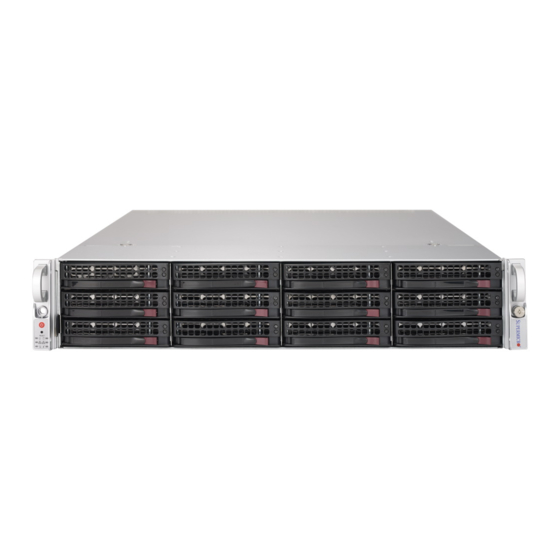
Table of Contents
Advertisement
Quick Links
Advertisement
Table of Contents

Summarization of Contents
Preface
About this Manual
Provides an overview of the manual's purpose, intended audience, and scope.
Notes and Support Information
Lists important notes, support contact details, and website references for updates.
Safety Warnings and Symbols
Highlights critical safety information, potential hazards, and symbols used throughout the manual.
Chapter 1: Introduction
System Overview and Specifications
Outlines the server's functions, features, and provides a list of main system components.
Unpacking and Setup Location
Provides instructions for unpacking the system and selecting a suitable installation location.
Chassis Features and Layout
Details the front and rear chassis features, including the control panel and drive bays.
Motherboard Layout and Quick Reference
Visual layout of the motherboard with component locations and quick reference tables.
System Block Diagrams
Illustrates the system architecture and component interconnections for different server models.
Component Replacement and Service
Guidance on obtaining replacement parts and procedures for returning merchandise for service.
Chapter 2: Server Installation
Installation Overview and Preparation
Advice and instructions for preparing the server for installation, including ESD precautions.
Rail Installation Procedures
Step-by-step guide for identifying, releasing, and installing chassis and rack mounting rails.
Chassis Rack Mounting
Instructions for securely mounting the server chassis into a rack, including stability considerations.
Chapter 3: Maintenance and Component Installation
Power Management and System Access
Procedures for safely removing power, accessing the system, and replacing components.
Motherboard Component Installation
Detailed steps for installing CPU, heatsink, memory modules, and motherboard battery.
Memory Support and Population
Information on memory types, capacity limits, population guidelines, and sequence.
Chassis Component Installation
Guidance on installing storage drives, NVMe drives, M.2 SSDs, and managing system cooling.
Power Supply and PCI Expansion Cards
Instructions for replacing power supply modules and installing PCI expansion cards.
Chapter 4: Motherboard Connections
Power and Connector Pinouts
Details main power connectors, backplane power, and GPU power connectors with pin definitions.
Headers and Connector Details
Explains fan headers, TPM, speaker, BMC, chassis intrusion, RAID key, and SMBus headers.
Control Panel and Front Panel Connections
Details on connecting control panel buttons and LEDs, including power and reset functions.
Input/Output Ports and Jumpers
Describes rear I/O ports, LAN ports, and motherboard jumpers for system configuration.
LED Indicators and Storage Ports
Explains various system LEDs, IPMI LAN LEDs, and physical storage interface ports.
Chapter 5: Software
Microsoft Windows OS Installation
Steps for installing Windows OS, including driver loading during the setup process.
Driver Installation Procedures
Guide to downloading and installing necessary system drivers from the Supermicro website.
SuperDoctor® 5 and BMC Configuration
Information on SuperDoctor 5 for system monitoring and configuring the Baseboard Management Controller (BMC).
Chapter 6: BIOS
BIOS Introduction and Main Setup
Overview of the AMI BIOS setup utility and navigating the main setup screen for system information.
Advanced BIOS Setup Configurations
Comprehensive guide to configuring advanced system settings, including boot, CPU, memory, and security.
BIOS Event Logs and IPMI Settings
Managing SMBIOS event logs and configuring IPMI settings for system monitoring and management.
BIOS Security and Boot Settings
Configuring BIOS security features, passwords, secure boot, and boot device order.
Save & Exit BIOS Options
Procedures for saving changes, discarding changes, and restoring default BIOS settings.
Appendix A: BIOS Error Codes
BIOS POST Error Beep Codes
Lists common BIOS POST beep codes, their error messages, and descriptions.
Appendix B: Standardized Warning Statements
General Safety Warnings
Explains industry standard warnings for bodily injury and electrical hazards.
Specific Equipment and Component Warnings
Details warnings for circuit breakers, power, batteries, fans, and cables.
Installation and Disposal Compliance
Guidelines on complying with electrical codes and proper product disposal regulations.
Appendix C: System Specifications
Processor, Chipset, and BIOS Specifications
Lists key specifications for processors, chipset, BIOS, memory, and drive bays.
Expansion Slots and I/O Ports
Information on PCI expansion slots, LAN ports, IPMI, USB, serial, and VGA ports.
Motherboard, Chassis, Cooling, and Power Supply
Specifications for motherboard, chassis dimensions, cooling fans, and power supply details.
Operating Environment and Compliance
Specifies operating temperature, humidity ranges, and regulatory compliance standards.
Appendix D: UEFI BIOS Recovery
UEFI BIOS Recovery Overview
Explains UEFI and the process of recovering the BIOS image when it is corrupted.
BIOS Recovery Procedures with USB
Step-by-step guide for recovering the BIOS using a USB device and the UEFI shell.
Appendix E: Crash Dump Using IPMI
Checking IPMI Error Logs
Steps to access the IPMI web interface and check event logs for processor internal errors (IERR).
Downloading Crash Dump Files
Instructions for downloading crash dump files from IPMI for troubleshooting and support.
Appendix F: GPUs in 2U Ultra Systems
GPU Installation Overview
Information on GPU support, thermal considerations, and expansion card slot configurations for 2U systems.
Adding GPUs to the Chassis
Step-by-step guide for installing GPUs, including riser card bracket and GPU positioning.
Appendix G: CPU-Based RAID for NVMe
Intel VROC Requirements and Setup
Details Intel VROC requirements, restrictions, and necessary patches or hardware keys for NVMe RAID.
Enabling NVMe RAID in BIOS
Guide to enabling NVMe RAID through UEFI BIOS settings and VMD configuration.
Hot Swap Drive Status and Related Links
Explains drive carrier status LEDs and provides links for hot-swap drive information.















Need help?
Do you have a question about the SuperServer SYS-6029U-TR4 and is the answer not in the manual?
Questions and answers